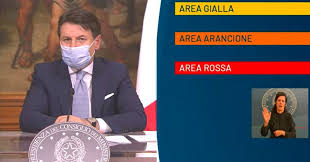Italy: Regions put under red, orange zone restrictions

Rome: Italian Prime Minister Giuseppe Conte has said that four regions have been declared red zones and two orange.
Under Italy’s latest emergency decree, a new national three-tier framework means some Covid-19 rules will now differ based on where you are in Italy.
The rules were to come into force on Thursday, but have now been delayed until Friday, Italian Prime Minister Giuseppe Conte said, in order to give affected businesses time to adjust.
Regions are to be divided into three categories: red, orange and yellow, under a new “traffic-light” system based on how severe the coronavirus situation is locally. (The government initially designated the lowest-risk zones green, but since changed the code to yellow to make clear that they still require caution.)
People in the highest-risk zones are told to stay within their comune, or municipality, and are only allowed to leave for work, study, health or other essential reasons, as Italy brings in the strictest measures since its two-month spring lockdown was eased.
Conte gave a televised address on Wednesday evening, two days after the new system was announced, detailing which regions would be under which category.
He confirmed that the regions are classified as follows: Red (high risk) zones: Lombardy, Calabria, Piedmont, Valle d’Aosta Orange (medium risk) zones: Puglia, Sicily
Yellow zones: All other regions; Abruzzo, Basilicata, Campania, Emilia-Romagna, Friuli Venezia Giulia, Lazio, Liguria, Marche, Molise Sardinia, Tuscany Umbria, Veneto, and the Provinces of Trento and Bolzano
“With these measures, we can cool the contagion curve and regain some semblance of normality,” Conte said in his address.
Red-zone restrictions will resemble those imposed earlier this year during a severe national lockdown, with residents’ movements curtailed.
But unlike then, churches and parks will be open, hairdressers will operate and restaurants can serve take-out food until the nighttime curfew.
Retail stores in those areas not selling essential goods such as food and pharmaceuticals are to shut, and people will be restricted from travelling outside their home town or city.
Schools will also have to move to distance learning from the second grade of middle school upwards in red zone areas, while this is only mandatory for high school classes in other areas
On a national level a 10pm curfew is in force from Thursday, museums will shut, and shopping centres will be closed at the weekend.
Italy’s Health Ministry decides which region is in which zone based on the advice of its Technical Scientific Committee (CTS), effectively bypassing regional authorities – many of which have said they were against a local lockdown or other tough measures.
The CTS takes 21 indicators into account including each region’s Rt number (which shows the transmission rate) as well as factors like hospital bed capacity and whether local health authorities are able to successfully trace the source of outbreaks.
The Ministry of Health is to revise the situation weekly and issue new ordinances every 15 days, according to the new decree.





